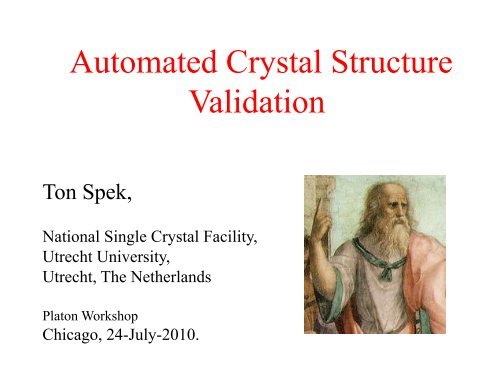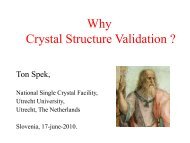Automated Crystal Structure Validation - National Single Crystal X ...
Automated Crystal Structure Validation - National Single Crystal X ...
Automated Crystal Structure Validation - National Single Crystal X ...
Create successful ePaper yourself
Turn your PDF publications into a flip-book with our unique Google optimized e-Paper software.
<strong>Automated</strong> <strong>Crystal</strong> <strong>Structure</strong><br />
<strong>Validation</strong><br />
Ton Spek,<br />
<strong>National</strong> <strong>Single</strong> <strong>Crystal</strong> Facility,<br />
Utrecht University,<br />
Utrecht, The Netherlands<br />
Platon Workshop<br />
Chicago, 24-July-2010.
Why <strong>Automated</strong> <strong>Structure</strong> <strong>Validation</strong><br />
<br />
• It is easy to miss problems with a structure as a<br />
busy author or as a referee<br />
• Increasingly: Black-Box style analyses done by<br />
non-experts<br />
• Limited number of referees & experts available<br />
• It is easy to hide problems with a ball-and-stick<br />
style illustration<br />
• Sadly, Fraudulous results and structures published<br />
and in the CSD<br />
• Even an ORTEP can hide problems =>
Is this a reasonable<br />
ORTEP <br />
Rotate
NO !<br />
Something has gone<br />
very wrong here
The CIF Standard Solution<br />
• The IUCr <strong>Automated</strong> <strong>Structure</strong> <strong>Validation</strong> project was<br />
pioneered and ‘pushed’ by Syd Hall, at that time section<br />
editor of Acta Cryst C. by:<br />
• The creation of the CIF Standard for data archival and<br />
exchange (Hall et al., (1991) Acta Cryst., A47, 655-685.<br />
• Having CIF adopted by Sheldrick for SHELXL93<br />
• Making CIF the Acta Cryst. submission standard<br />
• Setting up early CIF checking procedures for Acta<br />
• Inviting me to include PLATON checking tools such as<br />
ADDSYM and VOID search.
WHAT ARE THE<br />
VALIDATION QUESTIONS <br />
<strong>Single</strong> <strong>Crystal</strong> <strong>Structure</strong> <strong>Validation</strong> addresses<br />
three simple but important questions:<br />
1 – Is the reported information complete<br />
2 – What is the quality of the analysis<br />
3 – Is the <strong>Structure</strong> Correct
How is <strong>Validation</strong> Currently<br />
Implemented <br />
• <strong>Validation</strong> checks on CIF data can be executed at<br />
any time, both in-house (PLATON/CHECK) or<br />
through the WEB-based IUCr CHECKCIF server.<br />
• A file, check.def, defines the issues that are tested<br />
(currently more than 400) with levels of severity<br />
and associated explanation and advise.<br />
(www.cryst.chem.uu.nl/platon/CIF-VALIDATION.pdf)<br />
• Most non-trivial tests on the IUCr CheckCIF<br />
server are executed with routines in the program<br />
PLATON. (Identified as PLATxyz)
VALIDATION ALERT LEVELS<br />
CheckCIF/PLATON creates a report in the<br />
form of a list of ALERTS with the following<br />
ALERT levels:<br />
• ALERT A – Serious Problem<br />
• ALERT B – Potentially Serious Problem<br />
• ALERT C – Check & Explain<br />
• ALERT G – Verify or Take Notice
VALIDATION ALERT TYPES<br />
1 - CIF Construction/Syntax errors,<br />
Missing or Inconsistent Data.<br />
2 - Indicators that the <strong>Structure</strong> Model<br />
may be Wrong or Deficient.<br />
3 - Indicators that the quality of the results<br />
may be low.<br />
4 – Info, Cosmetic Improvements, Queries and<br />
Suggestions.
PLATON/CHECK CIF + FCF Results
Which Key <strong>Validation</strong> Issues are<br />
Addressed<br />
• Missed Space Group symmetry (“being Marshed”)<br />
• Wrong chemistry (Mis-assigned atom types).<br />
• Too many, too few or misplaced H-atoms.<br />
• Unusual displacement parameters.<br />
• Hirshfeld Rigid Bond test violations.<br />
• Missed solvent accessible voids in the structure.<br />
• Missed Twinning.<br />
• Absolute structure<br />
• Data quality and completenes.
Some Relevant ALERTS<br />
Wrong atom type assignments generally cause:<br />
• Serious Hirshfeld Rigid Bond Violation ALERTS<br />
• Larger than expected difference map minima and<br />
maxima.<br />
• wR2 >> 2 * R1<br />
• High values for the SHELXL refined weight<br />
parameter
Evaluation and Performance<br />
• The validation scheme has been very successful<br />
for Acta Cryst. C & E in setting standards for<br />
quality and reliability.<br />
• The missed symmetry problem has been solved<br />
for the IUCr journals (unfortunately not generally<br />
yet: There are still numerous ‘Marshable’<br />
structures).<br />
• Most major chemical journals currently have now<br />
some form of a validation scheme implemented.<br />
• Recently included: FCF validation
FCF-VALIDATION<br />
- Check of the CIF & FCF data Consistency<br />
(including R-values, cell dimensions)<br />
- Check of Completeness of the reflection data set.<br />
- Automatic Detection of ignored twinning<br />
- Detection of Applied Twinning Correction without<br />
having been Reported in the paper.<br />
- Validity check of the reported Flack parameter<br />
value against the Hooft parameter value.<br />
- Analysis of the details of the Difference Density<br />
Fourier Map for unreported features.
Sloppy, Novice or Fraudulent <br />
• Errors are easily made and unfortunately not always<br />
discernable from fraud.<br />
• Wrong element type assignments can be caused as part of<br />
an incorrect analysis of an unintended reaction product.<br />
• Alternative element types can be (and have been)<br />
substituted deliberately to create a ‘new publishable’<br />
structures.<br />
• Reported and calculated R-values differing in the first<br />
relevant digit !<br />
• FCF <strong>Validation</strong> is the tool to sort out this type of issues.
Published structure is claimed to form an<br />
infinite hydrogen bonded chain<br />
However: This structure does not include a dicarboxylic acid but the<br />
previously published para-nitrobenzoic acid.<br />
PROOF: Difference map calculated without the 2 carboxylic H-atoms
NO 2
There are clear ALERTS ! But apparently ignored
The Ultimate Shame<br />
• Recently a whole series of ‘isomorphous’ substitions was<br />
detected for an already published structure.<br />
• Similar series have now been detected for coordination<br />
complexes (Transition metals and lanthanides)<br />
• How could referees let those pass <br />
• Over 100 structures now retracted<br />
• Fraud detected by looking at all papers of the same authors<br />
of a ‘strange’ structure (and their institutions)
BogusVariations (with Hirshfeld ALERTS) on the Published <strong>Structure</strong><br />
2-hydroxy-3,5-nitrobenzoic acid (ZAJGUM)
Comparison of the Observed data for two ‘isomorphous’ compounds.<br />
Tool: platon –d name1.fcf name2.fcf<br />
The Only Difference<br />
Is the SCALE !<br />
Conclusion<br />
The Same<br />
Data !<br />
SLOPPY<br />
Or<br />
FRAUD
Info<br />
www.cryst.chem.uu.nl/platon/CIF-VALIDATION.pdf<br />
www.cryst.chem.uu.nl/platon/FCF-VALIDATION.pdf<br />
• Papers on structure validation:<br />
• A.L.Spek (2003). J. Appl. Cryst. 36, 7-13.<br />
• A.L.Spek (2009). Acta Cryst. D65, 148-155.




